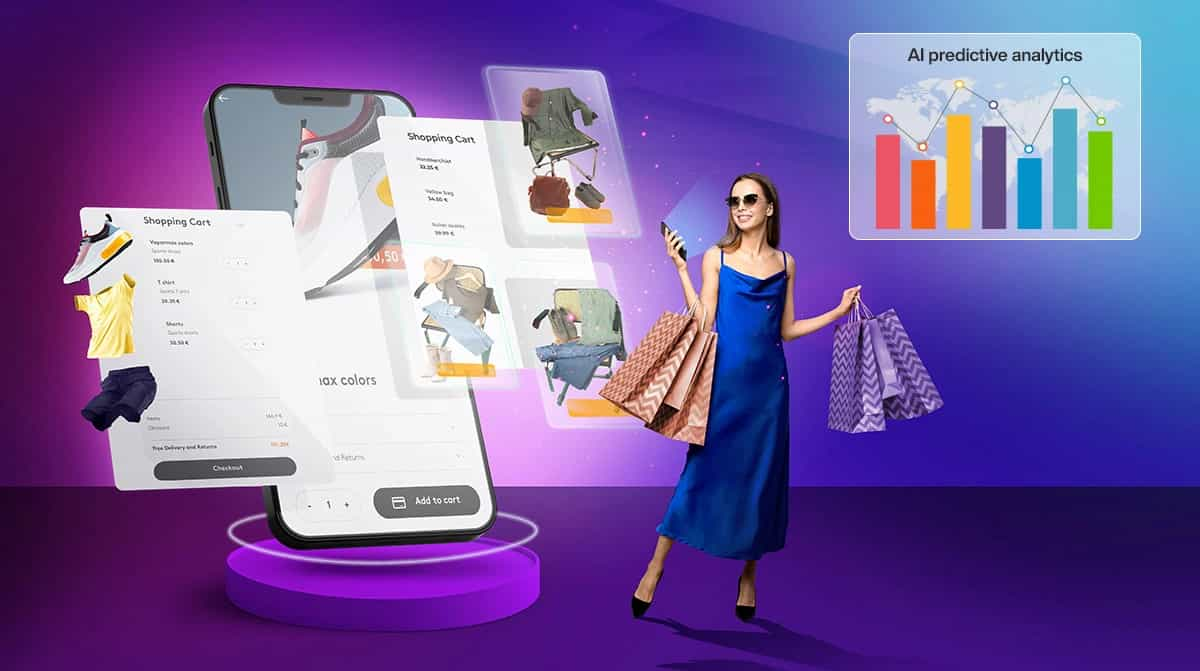Have you ever wondered how big brands like Amazon and Netflix come up with such accurate personal recommendations for products, movies, or television shows? It's no secret that people, including ourselves, are drawn toward services or stores that provide personalized experiences. To add to the impact of personalization, a study by Accenture revealed that 91% of consumers are more likely to shop with brands that show relevant offers and recommendations.
So, what makes such a scale of personalization seem so easy? It's all the power of a groundbreaking force that is reshaping the way we interact with the digital world - Generative AI. At the heart of this transformative wave are LLM (Large Language Models), NLP (Natural Language Processing), and advanced AI technologies that are not just disrupting industries but also propelling to new levels of efficiency, personalization, and unparalleled user experiences.
What is Generative AI?
A part of AI (Artificial Intelligence), Generative AI focuses on creating new content in images, text, audio, and more. While traditional AI relies on predefined rules and structured data to perform specific tasks, Generative AI can explicitly generate new, original content, not programs, into the system.
To summarize, here’s a differentiation between Generative AI and general AI:
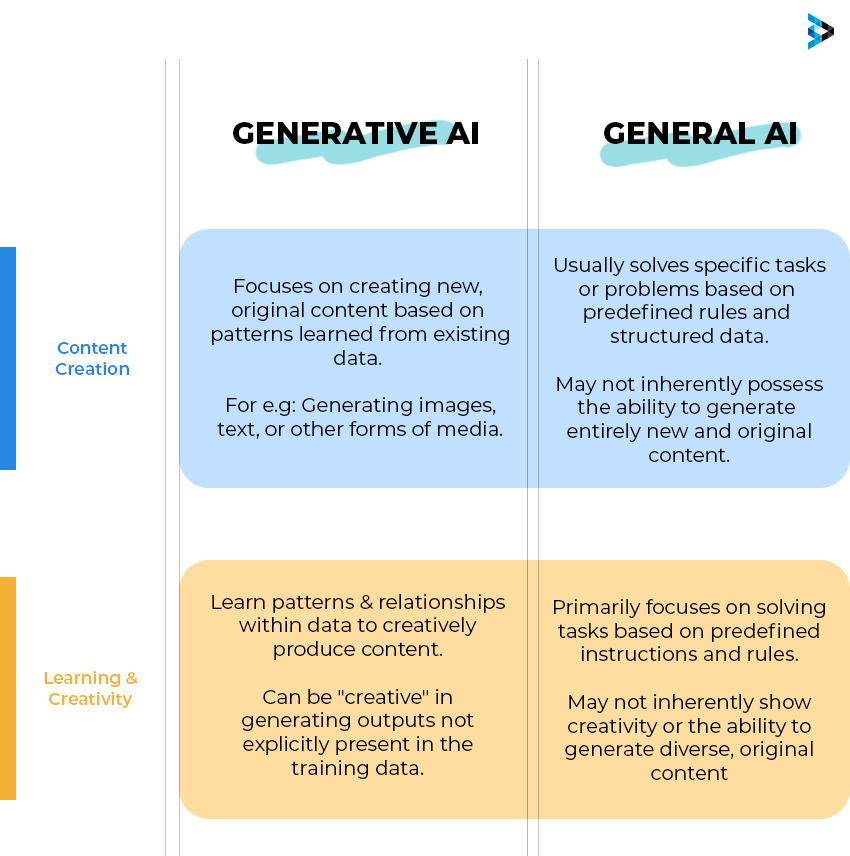
Generative AI can learn patterns and relationships within data with the help of advanced neural network architectures like GANs (Generative Adversarial Networks) or VAEs (Variational Autoencoders) and use them to generate new, close-to-realistic outputs.
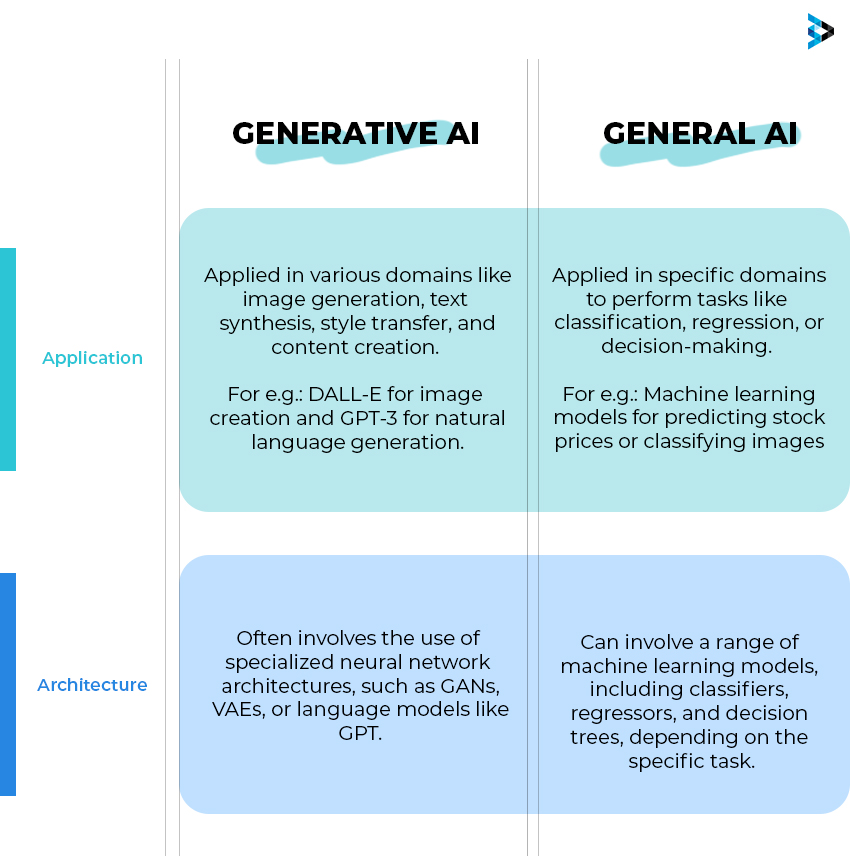
Generative AI in Retail eCommerce
The retail eCommerce industry, always a top-runner in technological adoption, is leveraging Generative AI to enhance customer engagement, streamline operations, and deliver hyper-personalized shopping experiences. From chatbots that provide instant, intelligent customer support to product recommendation engines that intuitively understand individual tastes, Generative AI in retail eCommerce is making big waves.
Moreover, a study by Gartner shows that businesses using virtual assistants and chatbots experienced a 70% increase in customer satisfaction.
But how is Generative AI doing this? The backbone of this revolution is LLM (Large Language Models). These are a type of AI model designed to understand and generate human-like language. They are also a subset of NLP (Natural Language Processing) and have become popular in recent years for their remarkable capabilities in text generation, translation, summarization, and more.
On the other hand, NLP is a field of AI focused on computer and human interaction through natural language. Its aim is to enable machines to understand, interpret, and generate human language in a meaningful and contextually relevant way. This field involves developing algorithms and models to analyze and derive meaning from large amounts of natural language data.
14 Use Cases of Generative AI in eCommerce
While we may have briefly touched upon some of the use cases of Generative AI in eCommerce, let's take a closer look at them.
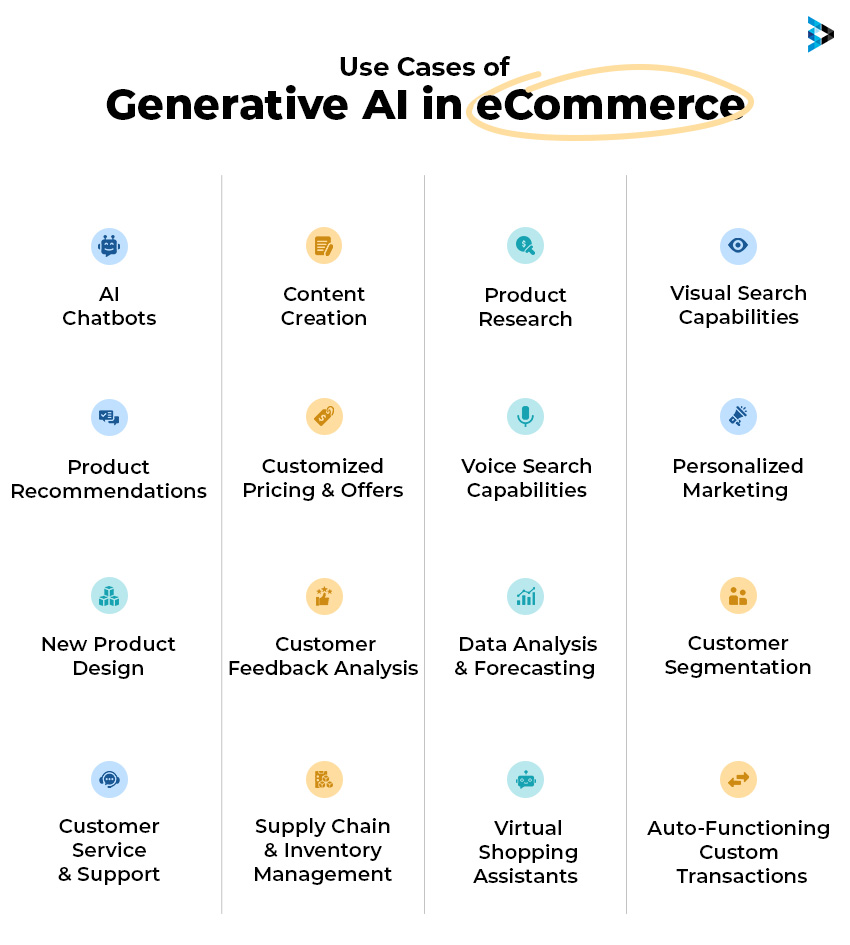
01 | Personalized Content Creation
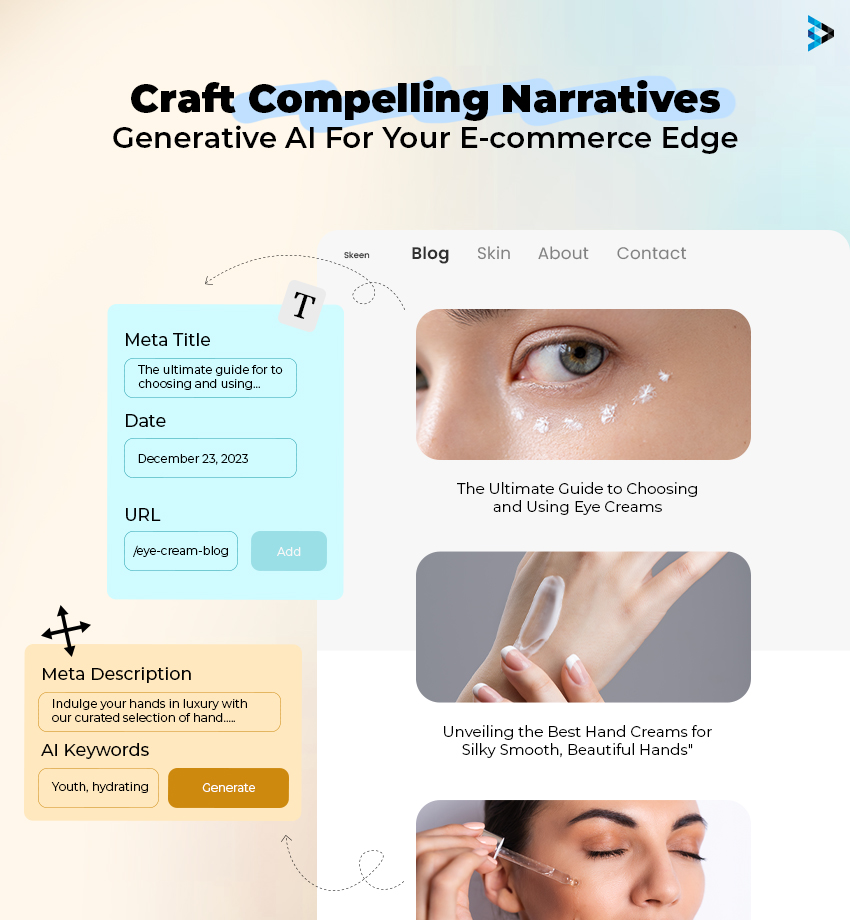
How Generative AI Assist in Content Creation?
- Product titles and descriptions writing
- Product comparisons
- Images and videos
- Informative content: blogs, whitepapers, articles
- Website content: About the company, contact information, processes, certifications
- Social media marketing content
- Online store marketing content
- Email marketing content
- Mobile marketing content: push notifications, app content, SMS marketing
- Advertising content and copywriting
- Customer communication
The Concern with Traditional Approaches
Traditionally, eCommerce writers would put their heads together and conduct extensive research, competitive analysis, and SEO keyword optimizations to craft this content. The challenge with this approach is the high time and effort consumption. Multiple writers working on the extensive content may also lead to inconsistency, impacting your sales and customer experience adversely.
Furthermore, the A/B testing to identify what works best adds to the hours and efforts in the entire process.
It is also difficult to create dynamic personalized content as per user preferences in this manner.
How Generative AI Can Help?
Generative AI can help you standardize your product descriptions with grammatical accuracy across different sellers and marketplaces. Working in synchronization with content creators and writers, the technology can help make the overall process much faster and efficient.
Reducing the time and effort consumed in research, the Natural Language Generation (NLG) algorithms can assess your product data and generate engaging descriptions.
Generative AI can also elevate ‘conversational commerce’ by understanding the user’s preferences and rewriting content like product descriptions and ad copies tailored to them - in real time. This dynamic approach mirrors in-store guidance with its personalized product discovery process.
How it Works?
Imagine you're gearing up for a snow camping expedition nearby. You've been browsing for a durable tent, sleeping bag, and other essentials online. The eCommerce platform, powered by Generative AI, notes your interest in lightweight and compact gear.
The platform will now dynamically adjust product descriptions based on your preferences. For the tent you're viewing, the content will highlight its lightweight design, weather-resistant materials, and ease of setup. Recognizing your IP location, say Colorado, it will suggest gear suitable for the Rocky Mountains' varying conditions and provide nearby camping sites. If there's an upcoming cold front, it may recommend a sleeping bag with enhanced insulation.
To further enhance your shopping experience, it will generate user-focused guides, like "Essential Gear for High-altitude Camping". And based on your interest in specific products, it may offer personalized promotions, like a discount on a compact camping stove if purchased with the selected tent.
Additionally, it can also come up with personalized product recommendations based on your preference - more on that soon!
Popular eCommerce Brands Leveraging this Use Case
- Amazon
- Alibaba
- The North Face
- Sephora
02 | Personalized Product Recommendations
Another leaf in the Generative AI for Personalization booklet is personalized product recommendations. Notice how Amazon provides uncannily personalized product recommendations? The "Customers who bought this also bought" and "Recommended for you" features shine a bright light on their use of Generative AI.

How Generative AI Can Help in Product Recommendations?
AI algorithms analyze large amounts of user data, including browsing history, purchase behavior, and preferences, to offer personalized product recommendations. These recommendations build a more personalized and targeted shopping experience, increasing the chances of conversion and customer satisfaction.
Further demonstrating the contribution of AI-driven recommendations to the bottom line, a study by Barilliance showed that 31% of eCommerce revenues result from personalized product recommendations.
Other Notable Benefits of Personalized Product Recommendations
- Reduced abandoned carts
- Increased AOV (Average Order Value)
- Improved session times/time spent on the platform
- Competitive advantage
03 | Virtual Shopping Assistants and Chatbots
IBM reported that businesses using AI-powered chatbots save up to 30% on customer service costs.
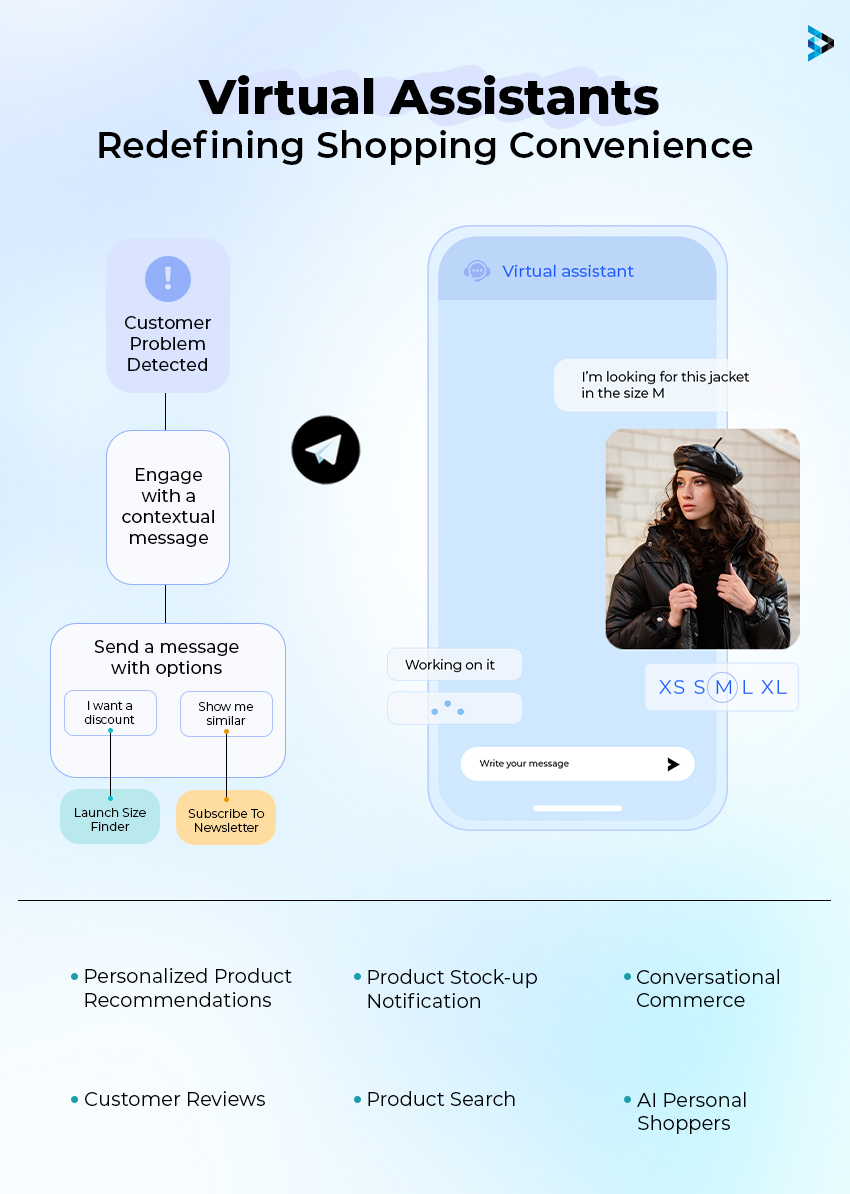
The Concern with Traditional Approaches
Customer service and support is undoubtedly a highly demanding sector. When you offer 24/7 assistance, having manual resources to attend to it and the often huge surge of queries and issues becomes very difficult. These challenges can affect overall customer experience, leading to lesser conversions, and tainted brand reputations.
That’s where AI can step in, and Generative AI can further enhance the process, being so dynamic in nature.
How Generative AI Enabling Virtual Assistants?
Powered by Generative AI to simulate human-like interactions, these virtual shopping assistants and chatbots provide:
- Real-time assistance to users
- Assistance with navigating through products
- Prompt answers to queries
- Personalized recommendations
- Cost-effective enhancement of customer engagement and support for your business
Popular eCommerce Brands Leveraging this Use Case
If you haven't already, check out how Sephora, the French multinational personal care and beauty products retailer, uses a virtual assistant on its website and mobile app to assist customers in finding products, offer beauty tips, and provide personalized product recommendations, replicating in-store consultation.
04 | Supply Chain and Inventory Management
The Concern with Traditional Approaches
Among the significant challenges in supply chain and inventory management are demand forecasting, lack of real-time visibility, risk management, and inventory optimization, where overstocking can tie up your capital and warehouse space while understocking can lead to stockouts and missed sales opportunities.
How Generative AI Revolutionizing SCM ?
Here’s how large and highly successful hypermarkets like Walmart overcome these challenges with AI in its supply chain -
Generative AI optimizes supply chain and inventory management by analyzing historical data, predicting demand, and automating inventory processes. This technology helps Walmart reduce stockouts and enhance its overall efficiency!
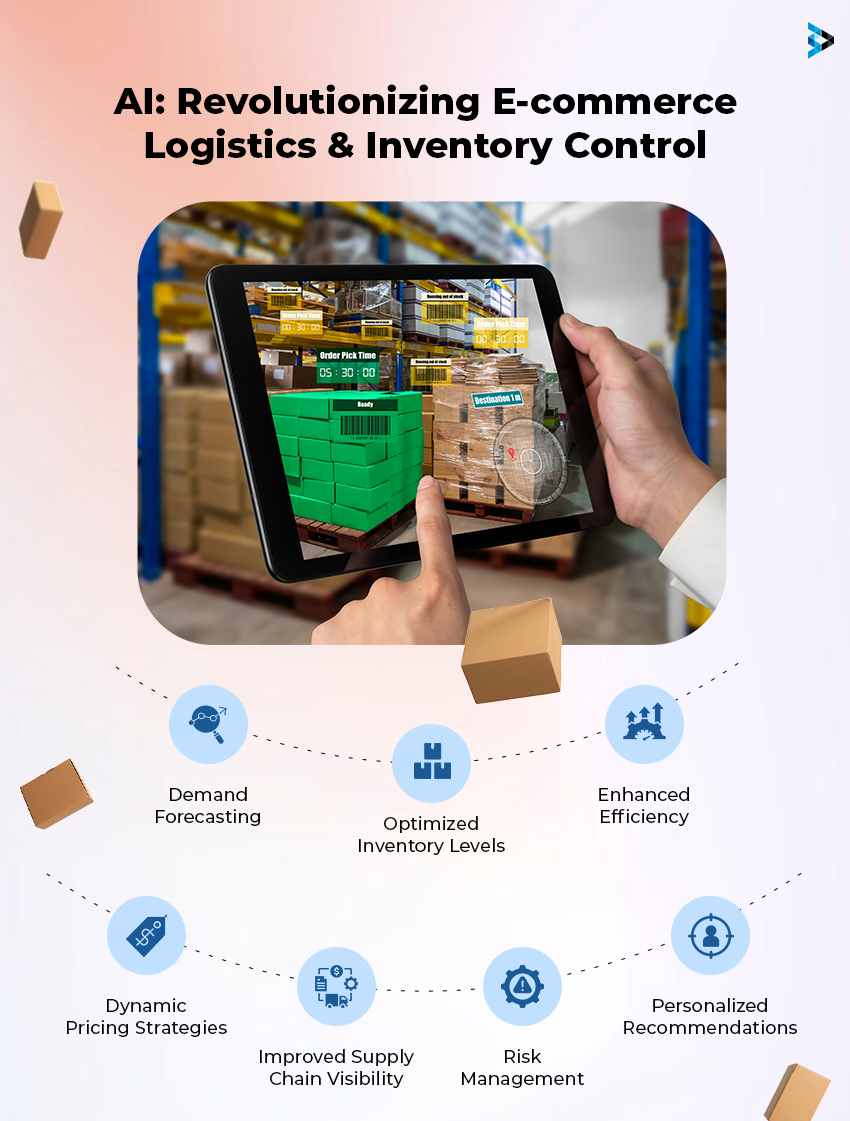
And if you're wondering how cost-effective and accurate it can be, Accenture estimates that AI-driven improvements can lead to a 20% reduction in supply chain costs and a whopping 50% reduction in forecasting errors.
05 | Customized Pricing and Offers
We're all familiar with how Uber adjusts its ride fares based on demand, traffic conditions, and other factors. While 'surge pricing' may not be an advantage for users, the personalized pricing strategy provides fair pricing during peak times while optimizing driver incentives. No points for guessing what makes this custom pricing work!
The Concern with Traditional Approaches
Personalization in itself is too vast a pool to jump in with completely manual resources. You need to have a humongous amount of data like your audience’s purchasing history, browsing behavior, demographics, and preferences. Customized pricing further takes into account the unique characteristics and behaviors of each customer to provide a more personalized and targeted shopping experience.
How Generative AI Can Help?
Generative AI analyzes vast amounts of customer data, including past purchases, browsing behavior, and preferences. It helps you:
- Implement dynamic pricing strategies based on real-time market conditions, competitor pricing, and customer behavior, ensuring competitiveness, profitability, and maximized revenue
- Identifying and implementing loyalty programs, personalized discounts, and exclusive deals for high-value customers, encouraging them to return and make additional purchases, fostering customer loyalty by acknowledging and rewarding repeat business
- Craft targeted marketing campaigns based on customer segments and preferences to improve the effectiveness of your marketing efforts and drive higher conversion rates
- Quickly adapt pricing strategies and promotional offers based on emerging trends
- Optimize inventory management by analyzing demand patterns and adjusting prices to align with inventory levels, helping prevent overstocking or stockouts and improving overall supply chain efficiency
Popular eCommerce Brands Leveraging this Use Case
Similar to Uber, retail eCommerce platforms use Generative AI to dynamically adjust pricing based on individual customer purchasing history, browsing patterns, and real-time demand.
- Airlines and hotel chains optimize their pricing dynamically as per seasonal demand, booking patterns, and personal customer behavior
- Brands offering subscription-based services customize pricing and promotional offers for individual subscribers
Other popular brands leveraging Generative AI for customized pricing and offers in eCommerce include:
- eBay
- Walmart
- Zalando
These examples highlight how Generative AI for dynamic pricing can enhance customer satisfaction and encourage long-term subscription commitments. Additionally, a study by McKinsey showed a 9% increase in average revenue and an 8% increase in profit margins among businesses leveraging dynamic pricing with AI.
06 | Visual Search Capabilities
In 2018-2019, Pinterest, the pioneer in visual search, reported a 140% YoY increase in visual searches since its introduction of Lens.
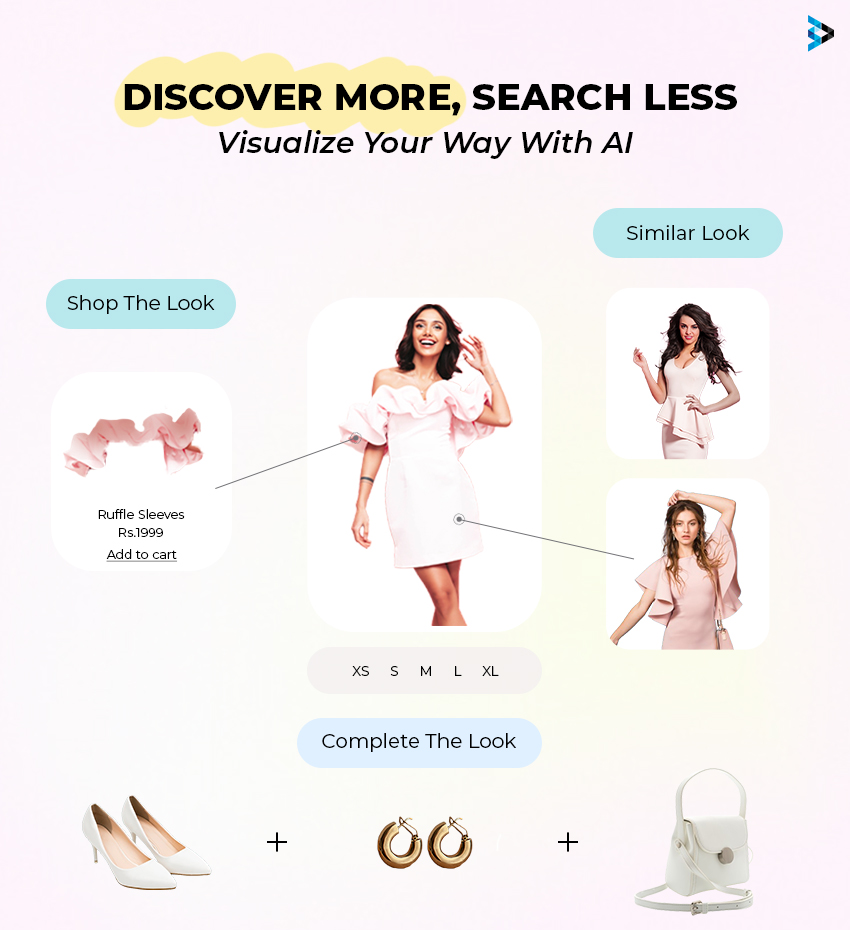
Lens is a sophisticated AI and ML (Machine Learning) technology that identifies objects and their attributes in Pin images and returns visually and contextually similar recommendations. The result? A more intuitive search experience for users.
Similarly, visual search can also be used on the eCommerce platform itself, to enhance the user experience, simplify product discovery, and align with the growing trend of visual-first interactions in online shopping.
How Generative AI Enhancing Visual Search?
While traditional visual search primarily relies on computer vision and image recognition, Generative AI intelligently creates more contextually relevant and personalized search results.
- When a user performs a visual search, Generative AI can create variations or similar products based on the input image, expanding the range of results and offering users more options
- Generative AI models, including advanced language models, can be trained to understand the context and content of images more comprehensively for more accurate interpretation of user queries and, in turn, delivers more relevant visual search results
- Incorporating user behavior, preferences, and historical data, Generative AI can personalize visual search results for individual users and give them recommendations based on the visual similarity of products along with their past interactions and preferences
- With ‘style transfer’, it can help users find products that match the aesthetic of their visual search
- It can dynamically synthesize visual elements like colors, patterns, or features, to create unique and novel results, enabling you to showcase visually appealing and unique products that align with a user's preferences
- With AR (Augmented Reality) integration, it can enhance virtual try-outs - like using a visual search to find furniture and then using AR to see how the piece looks in your living room
- It can assist in creating visual content for recommendation modules, like personalized banners or product carousels, ensuring it aligns with your aesthetic and branding
Other Notable Benefits of Visual Search
- An immersive, intuitive, and engaging shopping experience
- Increased conversion rates
- Discovery of similar products
- Reduced friction in mobile shopping
Popular eCommerce Brands and Platforms Leveraging this Use Case
- Google Shopping
- ASOS
- IKEA
- H&M
- Zara
07 | Product Research
Turning to search engines for informed decision-making has become quite the norm. Google states that 66% of smartphone users use their devices to make purchase decisions based on online research.
How do businesses leverage this? Adidas, the beloved German athletic apparel and footwear company, leverages Generative AI for product design and development.
How Generative AI Can Help?
Generative AI aids in product research by analyzing market trends, customer reviews, and competitor data. It provides valuable insights that assist the brand in making informed decisions about developing new athletic apparel and footwear, marketing, and positioning.
The key advantages include:
- Market trend analysis for alignment with current consumer preferences
- Idea generation
- Rapid prototyping for quick and cost-effective testing of product concepts
- Enhancement of product personalization
- Consumer behavior analysis for decisions based on real-time and historical consumer data
- Enhanced data-driven decision making
- Reduced time-to-market by expediting different stages of product research, from ideation to prototyping
08 | Voice Search Capabilities
Narvar Inc., the customer experience platform based in California, reported that 43% of consumers use voice search to research products, while Voicebot.ai. said that 26% of voice assistant users purchased using voice search by September 2023.
With the growing trend of voice-driven interactions, voice search capabilities in your eCommerce platform can give you a competitive edge. And Generative AI can help you make the most of it.
How Generative AI Can Help?
- Generative AI models based on advanced natural language processing (NLP) can enhance the accuracy of voice recognition and understanding
- It facilitates hands-free and convenient product search, providing users with a more seamless and accessible shopping experience
- Coupled with machine learning algorithms, it can analyze user preferences and behavior to deliver personalized product recommendations through voice interactions
- Generative AI powers conversational agents/chatbots/ or voice-activated virtual assistants that engage in natural language conversations with users, assisting them in product discovery and purchase decisions
- Generative AI models can support voice search in multiple languages, catering to a diverse user base, expanding the reach of your eCommerce platform
- It can assist users in creating and managing shopping lists through voice commands, streamlining the process of planning and organizing purchases
- Voice search powered by Generative AI enhances accessibility for users with disabilities, helping them navigate your eCommerce platforms without relying on traditional input methods
- Generative AI models can learn and adapt based on user interactions, continually improving the accuracy and relevance of voice search results
How it Works?
Consider an example where you are using Amazon to stock up on essentials. You place an order through Alexa. The voice assistant suggests items that match your preferences based on your purchase history and more.
Popular eCommerce Brands and Platforms Leveraging this Use Case
People are increasingly relying on search engines and virtual assistants for product recommendations, purchase updates, and search queries. Among the most popular ones are:
- Amazon’s smart speaker - Amazon Echo and virtual assistant - Alexa
- Google’s Assistant
- Apple’s Siri
- Microsoft’s Cortana
Besides these virtual assistants, brands like the following are also leveraging Generative AI for voice search:
- Burger King - Remember their Super Bowl promotions and the phrase “Okay Google, what is the Whopper burger?”
- Whirlpool’s voice-activated appliances
- Estée Lauder
09 | Customer Service and Support
Customer service and support, especially in eCommerce, can be highly demanding. Meeting high customer expectations, 24/7 availability, multi-channel support, managing returns and refunds, fraud prevention, and more needs robust technology and well-defined processes besides ongoing training for support teams and a staunch commitment to customer-centricity. That's where Generative AI steps in.
How Generative AI Can Help?
AI-powered customer service and chatbots offer real-time support, answering customer queries and providing assistance promptly. It not only improves customer satisfaction but also reduces the workload on human agents. Moreover, according to Salesforce, 69% of consumers prefer chatbots for quick communication with brands.
Popular eCommerce Brands and Platforms Leveraging this Use Case
Check out how Delta Airlines utilizes a virtual assistant and chatbot to assist users with booking flights, checking flight statuses, and answering common queries on its website and mobile app.
10 | Customer Feedback Analysis
Harvard Business Review found that organizations leveraging AI for customer feedback analysis see a 25% increase in customer satisfaction.
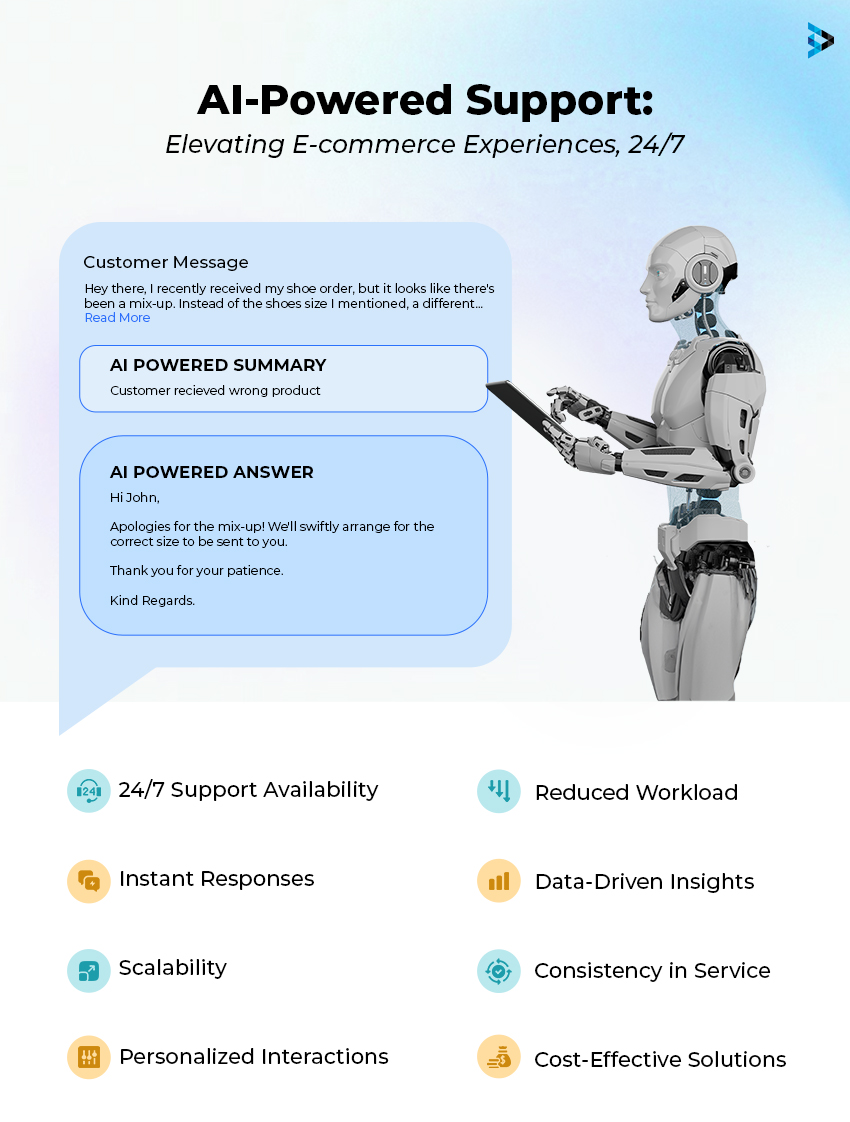
How Generative AI Can Help?
Generative AI analyzes customer feedback, reviews, and sentiments to extract valuable insights, enabling businesses to understand customer preferences, identify areas for improvement, and enhance their overall customer experience.
Popular eCommerce Brands and Platforms Leveraging this Use Case
A great example is how Airbnb uses AI's data-driven approach to analyze customer reviews and feedback to identify trends and improvement areas, enhancing its overall experience for hosts and guests.
11 | Data Analysis and Forecasting
According to Deloitte, companies using AI for data analysis and forecasting experience a 46% reduction in time consumed for data-related tasks.
Challenges with Traditional Approaches
- Unreliable insights and forecasts due to inaccurate or inconsistent data from various sources.
- A potential lack of sufficient historical data in new businesses or emerging markets
- Rapid changes in market conditions, influenced by external factors like economic downturns, global crises, or regulatory changes
- Missing or incomplete data points
- Highly complex models that may not necessarily lead to better predictions being challenging to interpret
- Limited computational resources in small businesses or those with limited resources for processing and analyzing large datasets
- Unintentional biases introduced by analysts during data interpretation
- Data security and privacy concerns
- Lack of cross-functional collaboration hindering the effectiveness of analyses
How Generative AI Can Help?
AI-driven data analysis and forecasting tools can help with:
- Analyzing vast datasets to identify patterns and behaviors, enabling precise customer segmentation beyond traditional demographics
- Leveraging historical data and real-time inputs to forecast sales with remarkable accuracy, optimizing your inventory, managing resources efficiently, and making informed decisions for future growth
- Uncovering associations within purchase behaviors through market basket analysis - a data mining technique to increase sales by better understanding customer purchasing patterns
- Analyzing user behavior, preferences, and historical data to offer highly personalized product recommendations
- Processing real-time market data, competitor pricing, and customer behavior for dynamic pricing strategies
- Analyzing the complete customer journey to predict the potential lifetime value of each customer
- Performing sentiment analysis on customer reviews, social media mentions, and feedback to help you gauge customer satisfaction, identify areas for improvement, and adapt strategies to align with customer sentiments
- Enhancing supply chain efficiency by analyzing historical data, predicting demand fluctuations, and optimizing inventory levels for a seamless supply chain process, minimized stockouts, and reduced excess inventory costs
12 | Personalized Marketing and Customer Segmentation
A report by Segment found that businesses using personalized marketing see an average increase of 20% in sales.
An example of this is Starbucks. The brand utilizes AI for personalized marketing campaigns, enhancing customer engagement and loyalty. Generative AI analyzes user data to understand preferences and behavior, enabling businesses to tailor their marketing messages, resulting in more effective and targeted communication.
13 | New Product Design
We've seen that Generative AI can help in product research and creativity for new products. But it can also help in the execution. By analyzing market trends, customer preferences, and design parameters, Generative AI streamlines the product development process. This efficiency, in turn, accelerates innovation, reduces time-to-market, and enhances the competitiveness of new products.
Benefits of Generative AI in New Product Design
- Ideation: Generative AI can analyze vast datasets of existing designs, market trends, and consumer preferences to generate novel and diverse design concepts, accelerating the ideation phase with a multitude of inspirations
- Automated Prototyping: It can assist in creating automated prototypes based on design parameters, enabling rapid iteration and experimentation
- Customization and Personalization: By understanding user preferences and historical data, it can suggest personalized design elements, enabling mass customization
- Style Transfer and Fusion: It can merge different design styles or transfer elements from one product category to another, encouraging hybrid and eclectic design approaches
- Material Selection Optimization: It analyzes material properties, cost factors, and design specifications to optimize material selection for durability, aesthetics, and affordability, enabling more informed decisions
- Biometric and Ergonomic Design: It can incorporate biometric data and ergonomic principles to optimize product designs for user comfort and usability
- Inspiration and Trend Analysis: It scans social media, design forums, and trend databases to identify emerging design trends, providing designers with up-to-date inspirations
- Iterative Design Enhancement: It facilitates iterative design improvements by analyzing user feedback, identifying pain points, and suggesting design modifications
- Cross-Disciplinary Collaboration: It encourages collaboration between designers, engineers, and other stakeholders by providing a common platform for ideation and exploration.
- Risk Mitigation: It can simulate and analyze potential design flaws or weaknesses, helping identify and address issues before physical prototypes are produced
McKinsey reports that companies leveraging AI for new product design and development can reduce their product development timelines by up to 50%, accelerating time-to-market for innovative products.
14 | Auto-Functioning Custom Transactions
In eCommerce, auto-functioning transactions are the automated processes users go through when making a transaction. These processes involve steps like:
- Product selection
- Adding items to the cart
- Entering shipping information
- Payment processing
- Order confirmation
The customization is based on user behavior, preferences, or past transaction history.
How Generative AI Can Help?
Generative AI automates these transactional processes, reducing manual intervention and minimizing errors. This automation leads to a more efficient and streamlined transaction, improving overall operational efficiency and customer satisfaction. By how much, you wonder? Aberdeen Group found that organizations implementing AI-driven automation in transactional processes reduced their processing time by 50% and error rates by 30%.
Potential Applications of Generative AI to Enhance Custom Transactions in eCommerce
- Customized Recommendations and Bundles: It can generate personalized product recommendations and bundle suggestions based on individual customer preferences, purchase history, and browsing behavior
- Automated Upselling and Cross-Selling: It can automatically identify opportunities for upselling or cross-selling complementary products
- Personalized Transactional Emails: It can customize transactional emails, including order confirmations, shipping notifications, and post-purchase recommendations
- Intelligent Transaction Routing: It can optimize transaction routing, ensuring efficient order processing, inventory management, and fulfillment
- Automated Loyalty Programs: It can manage and automate personalized loyalty programs, offering tailored incentives, discounts, or rewards based on individual customer transaction histories
- Predictive Transactional Analytics: It can analyze transactional data to predict future customer behavior to proactively address customer needs and preferences
- Chatbot-Enabled Transactions: Chatbots powered by Generative AI can facilitate and personalize customer transactions through conversational interfaces with real-time assistance and recommendations
Key Benefits of Generative AI in eCommerce
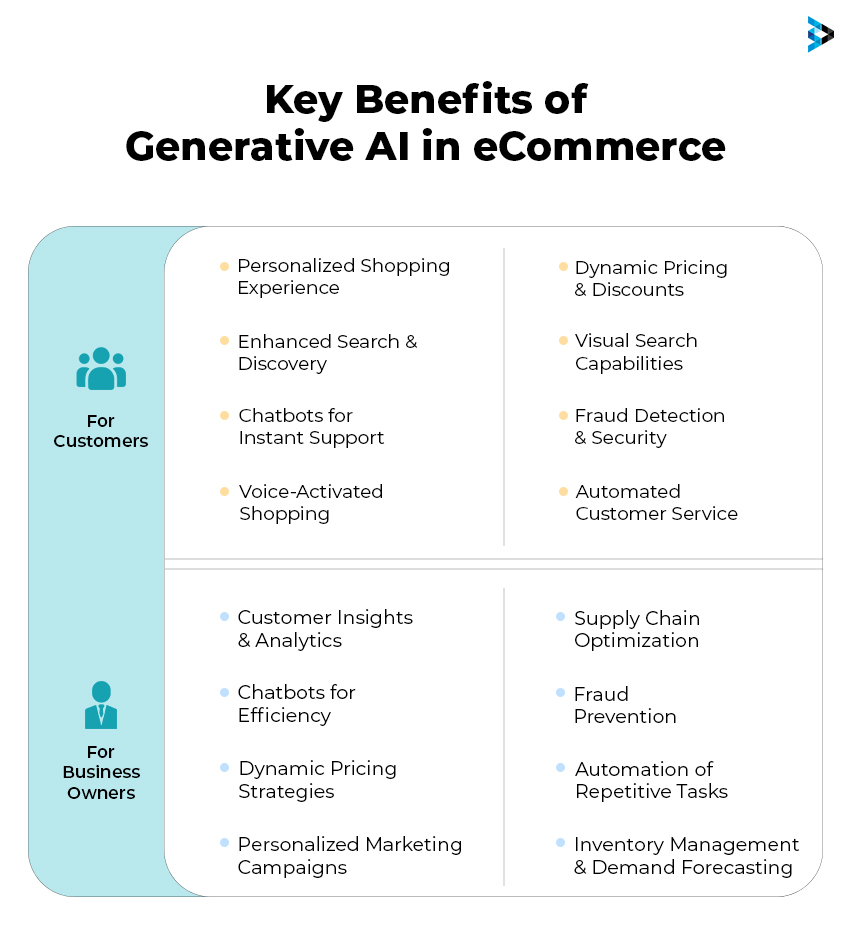
01 | Improving Fraud Detection
Generative AI enhances fraud detection mechanisms by regularly analyzing patterns and inconsistencies in transactional data. With its ability to learn from historical data, it can identify and mitigate potential fraudulent activities, providing enhanced security for your eCommerce platform.
02 | Analyzing Vast Amounts of Data
Generative AI excels at processing and analyzing the enormous daily datasets of eCommerce platforms swiftly and accurately. This capability helps you derive meaningful insights, identify trends, and make data-driven decisions efficiently.
03 | Increasing Sales and Conversions
Generative AI leverages user behavior and historical data to offer highly personalized product recommendations. With an understanding of individual preferences, it significantly increases the likelihood of users finding and purchasing products they are interested in, driving sales and conversion rates.
04 | Improving Customer Experience
With virtual shopping assistants and chatbots that provide instant, personalized assistance to customers, Generative AI not only streamlines the shopping process but also enhances customer engagement.
05 | Saving Costs and Increasing Efficiency
It contributes to cost savings by automating processes like supply chain management, inventory optimization, and fraud detection. The efficiency derived from these automated processes results in reduced operational costs and improved resource utilization.
06 | Enhancing Personalization
It enables your eCommerce platform to deliver hyper-personalized experiences. From personalized content creation to product recommendations, the technology ensures that users view content and products that align with their preferences, building a deeper connection with the brand and increasing customer loyalty.
Real-Time Examples from Popular Brands
Shopify, eBay, Etsy | Seller Relationships and Customer Experience
In August 2023, Shopify introduced Shopify Magic, an AI-enabled technology that initially generated product descriptions but now extends to creating blog posts, email subject lines, and online store headings. They also launched Sidekick, an AI-enabled commerce assistant, to help small businesses with sales analysis, store design ideation, and promotional instructions.
eBay employed generative AI with Magical Listing, enabling sellers to instantly populate detailed product information based on title, category, or features. Future iterations allow users to upload a product photo to generate title, category, description, and item specifics.
Etsy utilized AI and machine learning to organize and curate its marketplace. By integrating various search engine technologies, Etsy enhanced search result relevance. Machine learning also doubled the scale of Etsy's Best of Etsy library, curated based on visual appeal and craftsmanship. Additionally, machine learning aided in detecting listings violating Etsy's handmade policy, with a 29% increase in removals in H1 2023 compared to H2 2022. Etsy's democratization initiative enabled engineers to deploy machine learning models in days instead of months.
Amazon | Creating and Managing Product Listings for Sellers
In September 2023, Amazon announced it is leveraging Generative AI to simplify the creation of compelling product descriptions, titles, and details, making it faster and easier for sellers to list new products or enhance existing ones.
It will also significantly reduce the effort required for sellers to create comprehensive listings, improving the overall shopping experience for customers.
Myntra | App Chatbot for Enhanced Shopping Experience
Also in September 2023, Myntra introduced Maya, an AI-powered chatbot leveraging OpenAI's ChatGPT, for users on its app.
Initially available to 10% of Myntra's user base, Maya aims to provide a more natural conversational search experience resembling interactions with a sales assistant. Users can navigate Myntra's extensive range of styles by asking specific and intricate questions.
The chatbot utilizes ChatGPT's query understanding and conversational capabilities. Future developments include summarizing ratings and reviews, aiding size selection, and adding voice and image capabilities.
5 Tools to Integrate Generative AI with Your eCommerce Store
01 | OpenAI’s GPT (ChatGPT)

Type and Purpose: LLM (Large Language Model) using natural language processing to create human-like conversations
Benefits of integrating ChatGPT for your eCommerce store:
- Revamping and creating product listings
- Generating content ideas
- Automating customer service
- Analyzing product reviews for valuable insights
- Creating compelling content for marketing, emails, social media, and advertising
- Managing data more efficiently
- Creating conversational chatbots for instant support and navigation assistance for users to enhance interactions
- Generating personalized product recommendations
- Facilitating natural language search capabilities on the platform
Natural language search: A search based on regular spoken language instead of keywords. Verbal search queries from the users get translated into something the computer can understand and respond to.
Fun Fact: ChatGPT is an abbreviation of ‘Chat Generative Pretrained Transformer’.
02 | Jasper.ai

Type and Purpose: LLM (Large Language Model) copywriting/writing assistant
Benefits of integrating Jasper for your eCommerce store:
- Generating original content ideas
- Creating high-quality product descriptions
- Tailoring copy and personalized content for varied marketing platforms
- Enhancing content to make it more engaging and visually appealing
- Targeting specific keywords and phrases that your customers are searching for
Fun Fact: Jasper.ai was formerly known as Jarvis.ai, but rebranded itself to avoid issues and confusion with J.A.R.V.I.S - Tony Stark’s AI assistant from Marvel and Disney.
03 | OpenAI’s DALL-E

Type and Purpose: Text-to-image model to create realistic images and art from natural language descriptions
Benefits of integrating DALL-E for your eCommerce store:
- Generating unique and visually appealing product images to showcase product variations
- Creating custom graphics for promotions
- Generating unique visual content for marketing materials
- Enhancing the visual appeal of your products and marketing collateral
- Making the online shopping experience more engaging for your customers
Fun Fact: The name ‘DALL-E’ was coined by combining ‘Salvador Dali’, the iconic Spanish surrealist artist known for his technical skills, with Pixar's 2008 movie, ‘WALL-E’.
04 | TensorFlow/PyTorch

Type and Purpose: End-to-end open source deep learning frameworks used to power ML implementations and commonly used in applications like image recognition and language processing
Benefits of integrating TensorFlow or PyTorch for your eCommerce store:
- Building and training custom generative models tailored to specific eCommerce needs
- Creating personalized recommendation engines
- Developing custom image generation models
- Implementing advanced data analysis and forecasting tools
Fun Fact: Giants like Disney and Tesla have leveraged PyTorch, while Google has leveraged TensorFlow in products like Gmail, Translate, and Search.
05 | Amazon Web Services’s (AWS’s) Rekognition

Type and Purpose: Deep learning-based image and video analysis service
Benefits of integrating Rekognition for your eCommerce store:
- Empowering your business to stay ahead in technological innovation
- Enhancing image processing capabilities
- Automating the tagging and categorization of product images
- Ensuring visual content is appropriately labeled and organized
- Providing a more interactive, personalized, and visually appealing online shopping experience for customers
Fun Fact: Rekognition can also perform sentiment and demographic analysis.
Challenges and Limitations of Generative AI in eCommerce
While Generative AI in eCommerce promises transformative benefits, it does have its share of challenges and limitations.
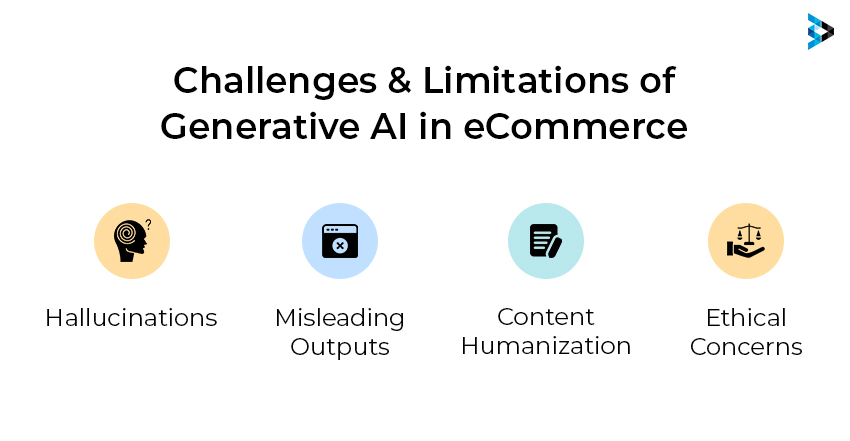
01 | Hallucinations
One of the most significant hurdles is the potential for hallucination, wherein AI models may generate inaccurate, unrealistic, or misleading content. This issue can raise concerns about information reliability, affecting customer trust in your eCommerce platform.
Ethical Concerns
There may also be ethical considerations, especially regarding the responsible use of AI-generated content, potential algorithm biases, and the implications of data-driven decision-making.
02 | Misleading Outputs
Generative AI's effectiveness largely relies on the quality and quantity of data available. Insufficient or biased data can result in flawed recommendations or misleading outputs.
03 | Content Humanization
The humanization of content poses another challenge. It becomes crucial to strike the right balance between personalized experiences and respecting user privacy.
However, with the continuous advancements in AI research, robust ethical frameworks, and a meticulous approach to data quality and privacy considerations, it is possible to address these challenges.
Leveraging Advanced Technologies with Generative AI
Fusing advanced technologies with Generative AI can open up many benefits to elevate your eCommerce customer experience, streamline operations, and drive your business growth. Here's a list of six advanced technologies you can consider:
01 | AR (Augmented Reality) and Virtual Reality (VR)
To enhance customer engagement, you can revolutionize your online shopping experience with AR and VR through interactive product visualizations, AI-driven personalized shopping recommendations, and virtual try-ons. Better customer engagement will lead to higher conversion rates and increased retention.
02 | Advanced Data Analytics
Leveraging Generative AI's capability of processing vast amounts of data, you can apply AI-driven analytics to process customer data, enabling precise insights into user behavior, preferences, and trends. These insights will help you make informed decisions faster, personalize your marketing strategies, and optimize your customer journey.
03 | Internet of Things (IoT)
Integrating AI with IoT devices can help enhance your eCommerce logistics and supply chain management efficiency. You can create a seamless and responsive eCommerce ecosystem with smart inventory systems, real-time shipment tracking, and personalized product recommendations based on IoT-generated data.
04 | Robotics and Automation
Through AI-powered robotics and automation, you can streamline your warehouse operations and ensure efficient order fulfillment with reduced operational costs. From automated inventory management to robotic picking and packing, these technologies enhance the speed and accuracy of eCommerce processes.
05 | Blockchain Technology
Combined with AI, Blockchain enhances your eCommerce transaction's security and transparency. Smart contracts powered by AI algorithms automate and validate transactions, reducing the risk of fraud and ensuring your platform's integrity.
06 | Edge Computing
Implementing AI at the edge in eCommerce ensures faster response times for personalized recommendations and real-time updates, making it especially advantageous for dynamic pricing, inventory management, and user interfaces.
Conclusion
As is evident, the transformation that Generative AI can bring to eCommerce is nothing short of revolutionary. It can reshape how we shop, sell, and experience the digital marketplace.
The use cases of Generative AI in eCommerce show how you no longer just predict trends but create them.
As global giants like Amazon, Shopify, and Etsy collaborate with Generative AI technologies, it's clear that Generative AI in retail eCommerce is not a fleeting trend but a paradigm shift - the future promises even more advanced applications, creativity, personalization, and efficiency.
FAQs
- What is Generative AI in eCommerce, and how does it benefit my store?
Generative AI in eCommerce is using AI (Artificial Intelligence) algorithms to create and enhance different aspects of your online shopping experience. It can help you personalize content creation, provide targeted product recommendations, and streamline tasks like inventory management. Generative AI in eCommerce transforms customer interactions, making them more engaging and intuitive, eventually driving conversions and business growth.
- What are the technical requirements or challenges in integrating Generative AI into my existing eCommerce platform?
The primary challenges in integrating Generative AI into your existing eCommerce platform include the potential need for robust computing infrastructure and skilled technical implementation, ensuring seamless integration, adapting to your platform's architecture, and addressing potential compatibility issues.
- What kind of customer insights and data analytics can I expect from utilizing Generative AI in my store?
You can get valuable customer insights from Generative AI's user behavior, preferences, and historical data analysis. These insights include personalized product recommendations, understanding purchasing patterns and predicting trends. The data analytics also empowers informed decision-making, helping you tailor your marketing strategies, optimize product offerings, and enhance overall customer satisfaction.
- What level of customization or fine-tuning is possible with Generative AI algorithms for my specific product catalog?
Generative AI algorithms are highly customizable. You can fine-tune with training models on your catalog data, ensuring more accurate and personalized content generation. It lets you align AI-generated outputs closely with your brand identity and customer preferences.
- How can Generative AI improve my eCommerce business's inventory management, demand forecasting, or supply chain processes?
Generative AI in retail eCommerce analyzes historical data and market trends, helping predict demand patterns and preventing overstock or stockouts. This analysis ensures efficient inventory levels, reduces carrying costs, and streamlines your supply chain operations, eventually enhancing your eCommerce business's overall efficiency and profitability.
- What security measures should I ensure when using Generative AI, especially for customer data and privacy?
When utilizing Generative AI, you can safeguard customer data and privacy by implementing encryption, secure data storage, and compliance with data protection regulations. Additionally, ensure that your AI solution complies with industry standards and the best practices, building trust and confidence among your clients.
Related Articles
Digital Transformation
Predictive Analytics for E-commerce Apps: How AI Anticipates Customer Needs & Boosts Sales
Digital Transformation
AI in Action: Revolutionizing Content Management and Delivery with Adobe Experience Manager Assets
Digital Transformation
Beyond the Launchpad: Why Dedicated Post-Migration Support is Your Shopify Success Secret Weapon



